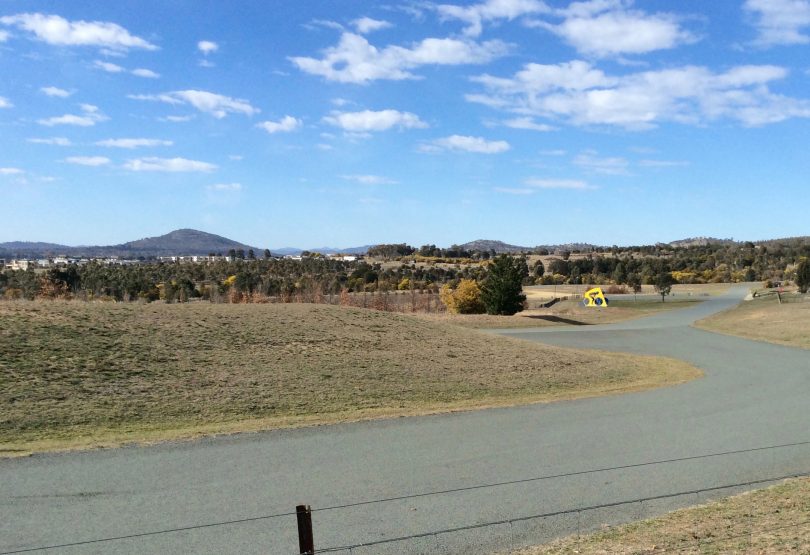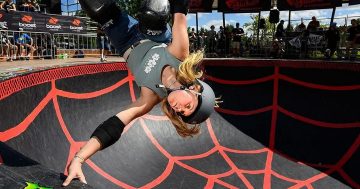
The Stromlo Criterium circuit is well used by Canberra cyclists. Photo: Tim Gavel.
Whenever a story about cycling appears, it activates an avalanche of pent up angst from the wider community.
Predominantly it’s anti-cyclists, and their arguments are based on a negative experience or a misconception.
The reaction to the story ‘Does the cycling community get a fair go in Canberra?’ on the need for more facilities illustrated this. If nothing else, it highlights why Canberra’s cycling community needs to present a better case, especially when it comes to cycling amenities.
Peter Rogers is part of a prominent Canberra cycling family. He rode as a professional, and his two brothers, Michael and Deane, are both former world champions.
Peter’s son Cameron is an emerging champion.
Peter is also captain of the Canberra Cycling Club, as well as being the outgoing president of Cycling ACT, so it’s fair to say he’s very aware of the local cycling environment.
“In 2004, Canberra’s sports cycling community identified the issue of growing demand for cycling [facilities] but decreasing access to safe venues due to city growth,” says Peter. “This was formalised within a proposal to government to build a multi-wheeled facility. Unfortunately, the facility was not funded.”
When Peter refers to the sports cycling community, he means the cyclists who compete in the sport of cycling, which is no different to, say, soccer or cricket.
There are also many Canberrans who ride for recreation or commute to work on the shared paths or the roads.
“The shared path system is great,” remarks Peter. “However, it presents safety issues relating to congestion and its narrow design. In most cases, if a bicycle rider wants a consistent ride or needs to travel longer distances, the roads are the only choice.”
The shared paths are highly populated most weekends with an influx of walkers, joggers, cyclists, dogs and electric scooters, while on the roads cyclist are mingling with cars.
“On a fine day with good weather, most experienced cyclists already question whether they should use bike paths because of congestion, and the paths are simply too narrow to safely cater for everyone,” Peter says.
So, to the current facilities for Canberra cyclists.
Canberra has two purpose-built sport cycling facilities comprising a locked gate (bookings only) velodrome in Narrabundah, with very steep and intimidating embankments, and a short 1.2-kilometre criterium circuit at Stromlo Forest Park. Both facilities are very well used during available daylight hours.
Beyond competition, the criterium circuit must also cater to the public. And it’s very popular with young families and their children. This is a fantastic use of a public facility, but the popularity further limits the sports cycling community’s ability to ride or train at these time in a safe car-free environment.
To make it even more prohibitive, there are no lights at either facility meaning the community cannot run participation programs or events during peak times, 7:00 pm to 10:00 pm.
“The community has been calling for purpose-built cycling facilities since 2004, and later, the facilities the community asked for were rationalised by government in the Stromlo Forest Park Mastering Plan in 2010. Once again, the funding is yet to be committed,” says Peter.
Key provisions for the sport and recreational component of cycling include a 12-kilometre road circuit around Stromlo and an extension of the current criterium circuit. These provisions have also been listed within five major priorities for Stromlo Forest Park by the SFP User Group Committee.
Given road cycling’s popularity, the proposed 12-kilometre cycling circuit and criterium extension would underpin local events and significantly take the burden away from shared paths and encourage more people to cycle because of the safer environment.
Part of the issue in formulating an argument for improved facilities has been the lack of data around participation. It is often hard to quantify because of the ‘self-organised’ recreational and commuting aspect of cycling.
It is far easier to assess participation in sports such as soccer as most players are registered with a club.
Another aspect has been the resistance of government to embrace the needs of the cycling community. Progress has been static to say the least.
The comments from many in the community to RiotACT provide a barometer of the work required to create greater understanding.
“I wasn’t surprised by the response,” says Peter, “And many of the opinions are perfectly valid in highlighting the shortcomings in Canberra’s active travel and sporting infrastructure investment. Active travel and sport play a major role in Canberra’s health and wellbeing. As the needs of Canberra’s growing population evolve, the design of our roads, shared paths and sporting infrastructure also needs to keep pace.
“The quicker government invest in ways to address the issues raised in this thread, the safer and happier everybody will be. If we all aspire to walking, jogging, cycling, and driving in harmony, it makes sense for city planners to step up and provide better solutions.”
Surely the time has come for the development of a workable master plan to create a safer environment for cyclists while at the same time relieving those impacted by them, particularly on the roads and cycleways.
Original Article published by Tim Gavel on The RiotACT.




